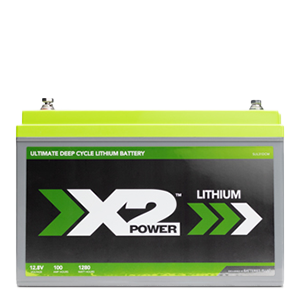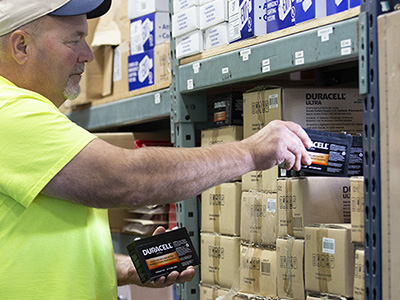Save Up To $150 on Select Marine Batteries - Buy Online & Pick Up In-Store - Limited Time - See Details
Why Consider Lithium Over Lead Acid Batteries?
On the Water You Require Reliability, Longevity, and Efficiency
10X
10 times longer life cycle
than a lead acid battery.
4X
Charges 4 times faster
than a lead acid battery.
2X
2 times more power
than a lead acid battery.

10 Year, 2000 Cycle Limited Warranty on X2Power Lithium Batteries With Bluetooth
- Low Self-Discharge
- Flexible Installation
- Consistent Power
- Lightweight
- Maintenance Free
- Super Safe
Shop X2Power Lithium Marine Batteries Shop X2Power Lithium Marine Chargers
Learn About the Different Types of Marine Batteries

Did you know...
Deep cycle batteries come in both AGM and lithium chemistries.
Deep cycle marine batteries feature a heavy charge and discharge cycle, making them perfect for long-lasting power on fishing boats, kayaks, and any other watercraft using a trolling motor or electric motor.
If you're operating a live well pump, depth finder or fish locator, a deep cycle marine battery generates the reliable, durable energy you need.
Deep cycle, or deep cell batteries are designed with fewer, but thicker plates, which means they can be discharged at a consistent rate for a longer time, at a higher depth of discharge.
It also means they can withstand high temperatures while providing high electrical currents. Deep cycle boat batteries can be drained and recharged many times; starting batteries can't. That's why they're typically used to power electric motors, and other applications, too.
Marine Battery Chemistry Types
At Batteries Plus you can find three different chemistries of marine batteries. The best one for you will depend on how hard you run your boat, your boat’s power demands and what accessories you have attached to it. Our suggestion? Select the battery that suits your boat’s needs.
Often called "wet cell" batteries, flooded batteries use a liquid sulfuric acid electrolyte to fill the case and cover the lead plates. This is where the term "flooded" comes from. Flooded batteries are not as rugged or vibration-resistant as other chemistries and must be mounted vertically to prevent electrolyte spillage. They self-discharge slightly more than other batteries, so you must ensure you charge them periodically in the off-season to keep them healthy.
They offer the lowest initial cost of all the batteries but require routine maintenance to ensure a long life. With proper care, flooded batteries can last several hundred charge cycles.
Compare the Top 4 Marine Batteries
At Batteries Plus you can find three different chemistries of marine batteries. The best one for you will depend on how hard you run your boat, your boat's power demands and what accessories you have attached to it. Our suggestion? Select the battery that suits your boat's needs.

Duracell Ultra
Flooded
- 12 month warranty
- Free replacement warranty
- Conventional technology
- Rugged design; vibration resistant
- Extended power & battery life

Duracell Ultra
Platinum AGM
- 30 month warranty
- Free replacement warranty
- AGM technology
- 20x more vibration resistant than conventional batteries
- High reserve capacity to power accessories

X2Power
AGM
- 48 month warranty
- Free replacement warranty
- AGM technology
- 28x more vibration resistant than conventional batteries
- Performs as both a starting and a deep cycle battery

X2Power
Lithium
- 60-120 month warranty
- Free replacement warranty
- Lithium chemistry
- Lasts 10x longer than traditional lead batteries
- Only to be used for deep cycle applications
Recommended Batteries for Common Applications
| Application | Deep Cycle or Lithium | Dual Purpose | Starting |
|---|---|---|---|
| Trolling Motor | Deep Cycle AGM or Lithium Recommended for Trolling Motor | Dual Purpose Recommended for Trolling Motor | Starting Not Recommended for Trolling Motor |
| Live Well Pump | Deep Cycle AGM or Lithium Recommended for Live Well Pump | Dual Purpose Recommended for Live Well Pump | Starting Not Recommended for Live Well Pump |
| Fish Finder | Deep Cycle AGM or Lithium Recommended for Fish Finder | Dual Purpose Recommended for Fish Finder | Starting Not Recommended for Fish Finder |
| Inboard/ Outboard Motor |
Deep Cycle AGM or Lithium Not Recommended for Inboard/Outboard Motor | Dual Purpose Recommended for Inboard/Outboard Motor | Starting Recommended for Inboard/Outboard Motor |
| Marine Lights | Deep Cycle AGM or Lithium Not Recommended for Marine Lights | Dual Purpose Recommended for Marine Lights | Starting Recommended for Marine Lights |
| Communication Radio | Deep Cycle AGM or Lithium Not Recommended for Communication Radio | Dual Purpose Recommended for Communication Radio | Starting Recommended for Communication Radio |
5 Simple Steps to Prolong the Life of Your Marine Battery
Keep track of your battery status. Monitor its state of charge/discharge and never let the charge fall below 50%. Letting batteries fall lower than a 50% charge regularly will dramatically reduce the life of your battery. If you have an X2Power Lithium Bluetooth boat battery, you can monitor it on your phone.
Choose an adequate battery size for your needs. Using a battery that is too small will force the battery to use more power than necessary and reduce the usable life of the battery.
Minimize your power demands. Arguably the most inexpensive way to increase life expectancy of your battery is to turn off unnecessary electronics when not in use, like fish finders, lights (when not necessary), etc.
Add an alternative energy source like solar panels or a wind turbine to help keep the batteries charged to optimal levels.
Equip a smart charging regulator to create the ideal charging environment to charge the battery with the boar’s alternator.
Tips for Maintaining Your Boat Battery
Get your current battery tested - Have your battery tested for free at Batteries Plus, especially if you've had your boat in storage for a season or more.
Get yourself a battery box - Use a battery box to minimize the impact of vibration and also to keep your battery secure. (Note that sometimes they're required by law.) An unsecured battery can cause damage to both the battery and your boat.
Keep connection points clean and electrolyte levels up - If you notice corrosion on your battery terminals, clean it up with a mixture of baking soda and water. If your boat carries a flooded battery, monitor the electrolyte levels before charging or operating your boat.
Waterproof chargers for the win - Waterproof chargers are perfect for your time on lakes, rivers or other waterways; you'll never find yourself on the water with a dead battery.
Note: Choose a charger with a high enough amperage for your battery.
From the Blog
FAQs
Modern automatic chargers ("smart") are safe to leave connected all the time. They automatically switch off & protect the battery from overcharging.
Older chargers: Must be disconnected once the battery has come to a full charge to avoid overcharge damage.
Charge marine batteries after each use and monthly for good health. Smart chargers make charging safe and easy.
Dual-purpose batteries handle both starting and deep-cycle needs, while deep-cycle batteries only handle sustained power. Choose dual-purpose if you need starting power and power to run accessories, otherwise deep-cycle for just powering equipment and accessories.
No. Deep-cycle batteries lack the burst power needed to start a boat. Using one as a starter stresses the battery and shortens its life. Stick to a dedicated starting battery for optimal performance and longevity.
The size of the battery depends on your boat's needs. Consider the type of engine, how much power you need, and whether you need one battery for both starting and deep-cycle applications or separate batteries for each.







